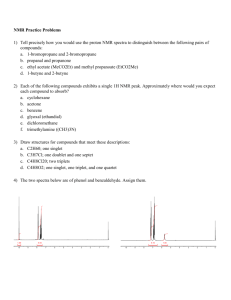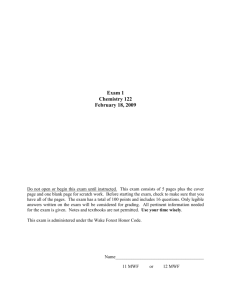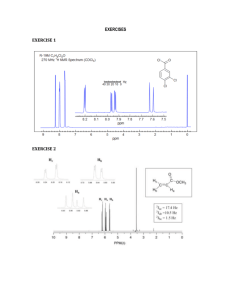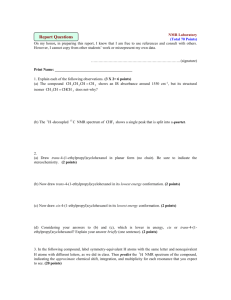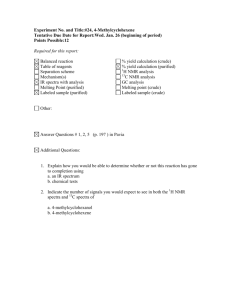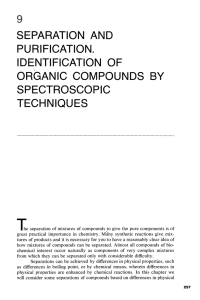NMR Practice Problems: Organic Chemistry
advertisement
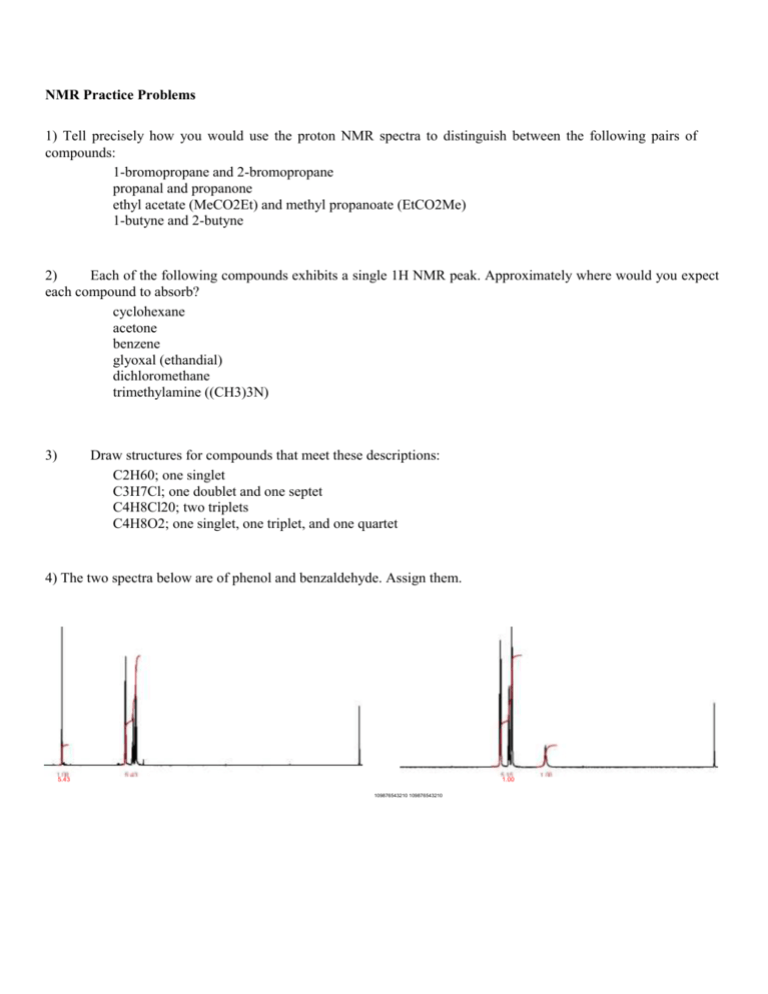
NMR Practice Problems 1) Tell precisely how you would use the proton NMR spectra to distinguish between the following pairs of compounds: 1-bromopropane and 2-bromopropane propanal and propanone ethyl acetate (MeCO2Et) and methyl propanoate (EtCO2Me) 1-butyne and 2-butyne 2) Each of the following compounds exhibits a single 1H NMR peak. Approximately where would you expect each compound to absorb? cyclohexane acetone benzene glyoxal (ethandial) dichloromethane trimethylamine ((CH3)3N) 3) Draw structures for compounds that meet these descriptions: C2H60; one singlet C3H7Cl; one doublet and one septet C4H8Cl20; two triplets C4H8O2; one singlet, one triplet, and one quartet 4) The two spectra below are of phenol and benzaldehyde. Assign them. 5.43 1.00 109876543210 109876543210 5) For each spectrum below, chose between the alternative compounds. Give your reasons. OH OO or OH 5.0 4.5 4.0 3.5 3.0 2.5 2.0 1.5 1.0 0.5 0.0 OH or OH 7.5 7.0 6.5 6.0 5.5 5.0 4.5 4.0 3.5 3.0 2.5 2.0 1.5 1.0 0.5 0.0 or 6.0 5.5 5.0 4.5 4.0 3.5 3.0 2.5 2.0 1.5 1.0 0.5 0.0 OH or 4.5 4.0 3.5 3.0 2.5 2.0 1.5 1.0 0.5 0.0 OH 6) The spectra below are of acetone, 1,2-dichloroethane, 1,1,2-trichloroethane, 2,2-dimethoxypropane, 1bromopropane and 2-bromopropane. Assign them. a) b) 6.0 5.5 5.0 4.5 4.0 3.5 3.0 2.5 2.0 1.5 1.0 0.5 0.0 6.0 5.5 5.0 4.5 4.0 3.5 3.0 2.5 2.0 1.5 1.0 0.5 0.0 c) d) 6.0 5.5 5.0 4.5 4.0 3.5 3.0 2.5 2.0 1.5 1.0 0.5 0.0 6.0 5.5 5.0 4.5 4.0 3.5 3.0 2.5 2.0 1.5 1.0 0.5 0.0 e) f) 6.0 5.5 5.0 4.5 4.0 3.5 3.0 2.5 2.0 1.5 1.0 0.5 0.0 6.0 5.5 5.0 4.5 4.0 3.5 3.0 2.5 2.0 1.5 1.0 0.5 0.0 7) Assign the following spectra to one of the compounds listed: 1,4-dimethylbenzene, 1,4-dimethoxybenzene, phenylethyne, 3-methyl-3-hydroxy-1-butyne, 2-bromobutane, 1,2-dibromo-2-methylpropane. 7.5 7.0 6.5 6.0 5.5 5.0 4.5 4.0 3.5 3.0 2.5 2.0 1.5 1.0 0.5 0.0 7.5 7.0 6.5 6.0 5.5 5.0 4.5 4.0 3.5 3.0 2.5 2.0 1.5 1.0 0.5 0.0 7.5 7.0 6.5 6.0 5.5 5.0 4.5 4.0 3.5 3.0 2.5 2.0 1.5 1.0 0.5 0.0 8) Propose plausible structures for the five compounds whose proton NMR spectra are shown: (a) C 4H10O2; (b) C7H7Br; (c) C4H9Br; (d) C8H9Br. a) b) 3.00 5.0 4.5 4.0 3.5 3.0 2.5 2.0 1.5 1.0 0.5 0.0 7.5 7.0 6.5 6.0 5.5 5.0 4.5 4.0 3.5 3.0 2.5 2.0 1.5 1.0 0.5 0.0 c) d) 2.00 2.00 3.5 3.0 2.5 2.0 1.5 1.0 0.5 0.0 7.5 7.0 6.5 6.0 5.5 5.0 4.5 4.0 3.5 3.0 2.5 2.0 1.5 1.0 0.5 0.0 9) Compound H,C9H12, gives a proton NMR spectrum as shown below. Assign a structure. 5.00 1.00 6.04 7.5 7.0 6.5 6.0 5.5 5.0 4.5 4.0 3.5 3.0 2.5 2.0 1.5 1.0 0.5 0.0 10) Two spectra are given below along with their molecular formulas. Propose a structure that corresponds to each spectrum. C3H7Cl 2.00 2.01 4.0 3.5 3.0 2.5 3.02 2.0 1.5 1.0 0.5 0.0 C9H10O2 0.52 6.0 1.05 5.5 5.0 4.5 4.0 0.56 3.5 3.0 2.5 2.0 3.00 1.5 1.0 0.5 0. 0 C ) 1.97 2.00 3.03 3.01 8.0 7.5 7.0 6.5 6.0 5.5 5.0 4.5 4.0 3.5 3.0 2.5 2.0 1.5 1.0 0.5 0.0 11) The integrated 1H NMR spectrum of a compound of formula C4H10O is shown. Propose a structure consistent with the data. 2.05 3.00 4.0 3.5 3.0 2.5 2.0 1.5 1.0 0.5 0.0 12) The compound whose proton NMR spectrum is shown below has the molecular formula C3H6Br2. Propose a plausible structure. 4.00 2.01 4.0 3.5 3.0 2.5 2.0 1.5 1.0 0.5 0.0 13) A compound (C10H12O2), whose spectrum appears below was isolated from a reaction mixture containing 2-phenylethnaol and acetic acid. Propose a structure for this compound. 5.00 2.00 2.00 3.02 7.5 7.0 6.5 6.0 5.5 5.0 4.5 4.0 3.5 3.0 2.5 2.0 1.5 1.0 0.5 0.0 14) The compound whose proton NMR spectrum is shown has the molecular formula C4H7O2Cl and shows an infrared absorption peak at 1740 cm^-1. Propose a plausible structure. 2.00 3.01 4.5 4.0 3.5 3.0 2.5 2.0 1.5 1.0 0.5 0.0 15) A small plant was adding bromine across the double bond of 2-butene to make 2,3-dibromobutane. A controller malfunction and allowed the reaction temperature to rise beyond safe limits. A careful distallation of the product showed that several impurities had formed, including the one whose NMR is shown below. Determine the structure. 1.00 2.01 2.00 3.00 4.5 4.0 3.5 3.0 2.5 2.0 1.5 1.0 0.5 0.0 16) When 2-chloro-2-methylbutane is treated with a variety of strong bases, the products always seem contain two isomers (A and B) of formula C5H10. When sodium hydroxide is used as the base isomer B predominates. Determine the structures of A and B and explain the experimental results. A) 1.00 9.00 5.5 5.0 4.5 4.0 3.5 3.0 2.5 2.0 1.5 1.0 0.5 0.0 B) 2.01 2.01 3.01 3.00 5.5 5.0 4.5 4.0 3.5 3.0 2.5 2.0 1.5 1.0 0.5 0.0 17) A new chemist moved into an industrial lab where work was being done on oxygenated gasoline additives. Among the additives that had been tested she found an old bottle containing a clear, pleasant smelling liquid but missing its label. She took a quick NMR and was able to determine the identity of the compound without additional information. Can you? The proton NMR is shown below. .. 2.02 1.04 2.03 3.00 4.0 3.5 3.0 2.5 2.0 1.5 1.0 0.5 0.0 18) An allylic halide A of formula C5H9Cl undergoes Sn1 reaction with water to yield a mixture of two isomeric products, B and C. The proton NMR spectra of B and C are shown. Suggest structures for A, B, and C. B) ..... ..... ..... ..... ..... ..... ..... .. . .. .. 2.00 2.01 4.0 3.5 3.0 2.5 3.02 2.0 1.5 1.0 0.5 0.0 C9H10O2 0.52 6.0 1.05 5.5 5.0 4.5 4.0 0.56 3.5 3.0 2.5 3.00 2.0 1.5 1.0 0. 0 0.5 C ) 㔀⸀㐀㌀ .. ..... ..... ..... ..... .. . 0.52 0.54 0.51 3.00 6.0 5.5 5.0 4.5 4.0 3.5 3.0 2.5 2.0 1.5 1.0 0.5 0.0

